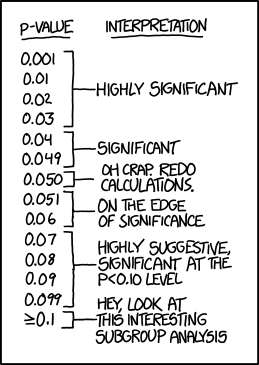Show the code
promoted not promoted Sum
male 21 3 24
female 14 10 24
Sum 35 13 482025-10-01
(A.K.A Hypothesis Testing)

https://xkcd.com/1478/
Follow along printed note available for this section
We consider a study investigating sex discrimination in the 1970s, which is set in the context of personnel decisions within a bank. The research question we hope to answer is, “Are individuals who identify as female discriminated against in promotion decisions made by their managers who identify as male?” (Rosen and Jerdee 1974 Note: The study allowed only for a binary classification of sex. The identities being considered are not gender identities.
48 male-identifying bank supervisors were asked to assume the role of the personnel director and were given personnel files to judge whether the person should be promoted. The files were identical except half indicated that the candidate identified as male, the other half the candidate identified as female. The files were randomly assigned to the participants, 13 individuals were promoted and the results were recorded.
❓ Is this an observational study or an experiment? Why?
❓How does the type of study impact what can be inferred from the results?
❓ What is the hypothesis being tested? (in words with no statistical jargon).
The results from the study are displayed in the following contingency table. Use it to fill in the blanks below.
promoted not promoted Sum
male 21 3 24
female 14 10 24
Sum 35 13 48In this study, a (bigger/smaller) proportion of female identifying applications were promoted than males (______________ versus ______________).
Calculate the difference (male - female) between these proportions.
This observed difference is what we call a point estimate of the true difference in promotional rates between males and females. This difference suggest there might be discrimination against women in promotion decisions, is unclear whether there is convincing evidence that the observed difference represents discrimination or is just due to random chance when there is no discrimination occurring.
Chance can be thought of as the claim due to natural variability; discrimination can be thought of as the claim the researchers set out to demonstrate. We label these two competing claims in the following way:
H0: Null Hypothesis:
HA: Alternative Hypothesis:
Often times, the null hypothesis takes a stance of no difference or no effect. This hypothesis assumes that any differences seen are due to the variability inherent in the population and could have occurred by random chance.
We will choose between the two competing claims by assessing if the data conflict so much with H0 that the null hypothesis cannot be deemed reasonable. If data and the null claim seem to be at odds with one another, and the data seem to support HA, then we will reject the notion of independence and conclude that the data provide evidence of discrimination.
To decide whether variability in data is due to
we set up a sham randomized experiment as a comparison.
Decision
If the actual experiment has more extreme results than any of the sham experiments, we are led to believe that it is the explanatory variable which is causing the result and not just variability inherent to the data.
Suppose the bankers’ decisions were independent of the sex of the candidate. Then, if we conducted the experiment again with a different random assignment of promotion to the files, differences in promotion rates would be based only on random fluctuation in promotion decisions. Let’s simulate this as a class so we can get lots of replications for this experiment.
Simulation Study
It’s your turn to assume the role of the bank personnel director and make a promotional decisions. Your group has been handed a stack of 48 confidential applications. Keep them face down for now.
Randomization Experiment spreadsheet, and fills out the first two columns.\# of promotions column in the spreadsheet.point estimate for the male-female difference in promotional rate and write it in your notes.Describe the distribution of this graph. What does it seem to be centered around?
In what percent of simulations did we observe a difference of at least 29.2% (0.292)?
In our analysis, we determined that there was only a ≈ 3.7% chance of obtaining a sample where ≥ 29.2% more male candidates than female candidates get promoted under the null hypothesis, so we conclude that the data provide some evidence of sex discrimination against female candidates by the male supervisors. In this case, we can reject the null hypothesis in favor of the alternative.
Statistical inference is the practice of making decisions and conclusions from data in the context of uncertainty.
Errors do occur, just like rare events, and the dataset at hand might lead us to the wrong conclusion. While a given dataset may not always lead us to a correct conclusion, statistical inference gives us tools to control and evaluate how often these errors occur.
